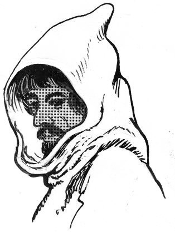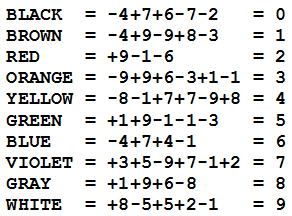From the postscript to a 1737 letter by Jonathan Swift — “Here is a rhyme; it is a satire on an inconstant lover.”
You are as faithless as a Carthaginian,
To love at once Kate, Nell, Doll, Martha, Jenny, Anne.
From the postscript to a 1737 letter by Jonathan Swift — “Here is a rhyme; it is a satire on an inconstant lover.”
You are as faithless as a Carthaginian,
To love at once Kate, Nell, Doll, Martha, Jenny, Anne.

stirious
adj. like an icicle
In 1957, the U.S. Patent Office wanted to design a computer that could track down earlier references to an idea submitted by an inventor. This is difficult, because patents are described in ordinary English, which uses many ambiguous and imprecise terms. The word glass, for instance, refers to a material, but also to any number of things made of that material, and even to objects that have nothing to do with glass, such as plastic eyeglasses and drinking glasses.
To solve this problem, engineer-lawyer Simon M. Newman planned a synthetic language called Ruly English that gave one and only one meaning to each word. In ordinary English the preposition through has at least 13 meanings; Newman proposed replacing each of them with a new Ruly term with a single meaning. The Ruly word howby, for example, means “mode of proximate cause.” It might replace the unruly terms by(take by force) or with (to kill with kindness) or through (to cure through surgery), but it always has the same basic sense.
Newman had to coin other terms to take account of differing points of view. A watch spring and a bridge girder are both flexible to some degree, but using the word flexible to describe both would leave a computer at a loss as to how they compare. Newman coined the Ruly word resilrig to cover the whole scale, from extreme flexibility to extreme rigidity, adding prefixes such as sli (slightly) and sub (substantially). So in Ruly English a bridge girder would be sliresilrig and a watch spring subresilrig. A computer that knew these terms would not be confused into thinking that a thin bridge girder was more flexible than a rigid watch spring.
“Humans are not expected to read or speak Ruly English,” noted Time in 1958. “To them, unruly English will always be more ruly.”
(Newman describes his plan briefly here. I don’t know how far he got.)
Boonville, Calif., has a dwindling language all its own. “Boontling” grew up as a jargon among residents of Anderson Valley around the turn of the 20th century. It includes more than a thousand words and phrases but is dying out among the small population. A brief glossary:
applehead – a young girl
belhoon – a dollar
Bill Nunn – syrup
boshin’ – deer hunting
bucky walter – a pay telephone
can-kicky – angry
dicking – cheating at cards
forbes – a half dollar
glow worm – a lantern
greeley – a newspaper or reporter
harpin’ tidrick – a lengthy discussion
high pockets – a wealthy person
killing snake – working very hard
pearlin – light rain
skee – whiskey
tobe – tobacco
walter – a telephone
zeese – coffee
“A few of us try to keep our skills sharp on the teleef [telephone],” resident Bobby Glover told the San Francisco Chronicle in 2001. “We’re adding new words now that the old-timers are gone.”
Thanks to the efforts of a number of researchers, the jargon has been pretty well documented now — the Chronicle even managed to translate “Old Mother Hubbard”:
The old dame piked for the chigrel nook for gorms for her bahl belljeemer
The gorms had shied, the nook was strung, and the bahl belljeemer had neemer.
affrontee
n. an insulted or offended person
In Gelett Burgess’ 1911 novel Find the Woman, a truck driver blocks the way of a parade organized by a society to ban profanity. He is addressed by Dr. Hopbottom, the society’s head:
See here, you slack-salted transubstantiated interdigital germarium, you rantipole sacrosciatic rock-barnacle you, if you give me any of your caprantipolene paragastrular megalopteric jacitation, I’ll make a lamellibranchiate gymnomixine parabolic lepidopteroid out of you! What diacritical right has a binominal oxypendactile advoutrous holoblastic rhizopod like you got with your trinoctial ustilaginous Westphalian holocaust blocking up the teleostean way for, anyway! If you give me any more of your lunarian, snortomaniac hyperbolic pylorectomy, I’ll skive you into a megalopteric diatomeriferous auxospore! You queasy Zoroastrian son of a helicopteric hypotrachelium, you, shut your logarithmic epicycloidal mouth! You let this monopolitan macrocosmic helciform procession go by and wait right here in the anagological street. And no more of your hedonistic primordial supervirescence, you rectangular quillet-eating, vice-presidential amoeboid, either!
The truck driver apologizes: “I see a plain, sea-faring man has no show with a doctor when it comes to exhibiting language in public. … If this here society what’s running this here procession can turn out graduates of the noble art of profanity like you are, I want to say this: Give me the pledge, and I’ll sign it.”

videnda
n. things worth seeing
As military and computer technology exploded in the early 1960s, Raytheon compiled a helpful list of 400 “space-age” abbreviations:
CHAMPION — Compatible Hardware And Milestone Program for Integrating Organizational Needs
COED — Computer Operated Electronic Display
DASTARD — Destroyer Anti-Submarine Transportable ARray Detector
PIPER — Pulsed Intense Plasma for Exploratory Research
It published the list in a booklet titled ABbreviations and Related ACronyms Associated with Defense, Astronautics, Business, and RAdio-electronics — or ABRACADABRA for short.

bardocucullated
adj. wearing a cowled cloak

From Lee Sallows: The international color code is used to mark the values of electronic components such as resistors. It assigns a distinct color to each of the 10 decimal digits, as seen in the center column of the table at right: 0 = BLACK, 1 = BROWN, …, 9 = WHITE.
Lee’s table has an ingenious reflexive property. The letters in the left-hand column are associated with the values -1 to -9, and those in the right-hand column with the values 1 to 9.
Now spelling the name of each color produces a sum that matches the number represented by that color:

“This is more remarkable that it may seem,” Lee writes, “because the numbers assigned to the letters are now restricted to single-digit values only.”
In one oft-repeated anecdote from the memoirs of Melville Stone, publisher of the Chicago Daily News in the 1870s, the News suspected that the Chicago Post and Mail, published by the McMullen brothers, was pirating its stories. The News retaliated by printing an account of a famine in Serbia, in which the local mayor was quoted as saying (ostensibly in Serbian) ‘Er us siht la Etsll iws nel lum cmeht.’ When the afternoon edition of the Post and Mail duly reproduced the quote, Stone ran to all the other Chicago papers to reveal the hoax: read backward, the supposed quote said ‘The McMullens will steal this sure.’ According to Stone, the Post and Mail never recovered from the embarrassment, and the Daily News was able to buy it for a pittance less than two years later.
— Stuart Banner, American Property: A History of How, Why, and What We Own, 2011
(Thanks, Keith.)